4th Symposium „Paths to ES“
Although the actual occasion was the 75th anniversary of Groddeck’s death, it was a cheerful gathering. Groddeck’s ES spurred us to scientific creativity, fruitful discussions and enjoyable get-togethers. More than 60 participants travelled to Baden-Baden for the three days, not just from Germany but also from the United States, Brazil and Italy.
The symposium was opened on Friday afternoon by Otto Jägersberg in the Gartenhaus of the municipal library, which was full to overflowing. After some words of welcome by the Lord Mayor of the City of Baden-Baden, Wolfgang Gerstner, the lectures began. The first afternoon was devoted to the philosophical and literary sides of Georg Groddeck.
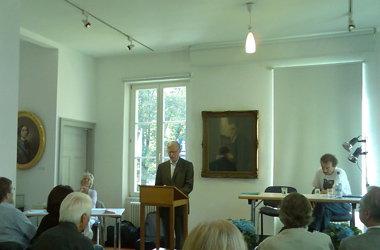 |
| © Helmut Grosch |
Otto Jägersberg then presented two of Groddeck’s early satires: “Einiges über moderne Kollegialität” and “Krankheit”.
After that, Galina Hristeva engaged critically and from a literary viewpoint with his publications from the 1890s in her lecture “Angina phlegmonosa. Georg Groddecks Ärztesatiren”. Hristeva acknowledged these as being of outstanding significance as milestones on the Path to the ES.
In the last lecture of that afternoon, Marie-Luise Wünsche took another approach to Groddeck’s literary work. Under the heading “Von dem ES, das erzählt, und einem Arzt, der zuhört, bevor er aufschreibt”, her ES set off a fireworks display for the psychoanalytical-psychosomatic writer.
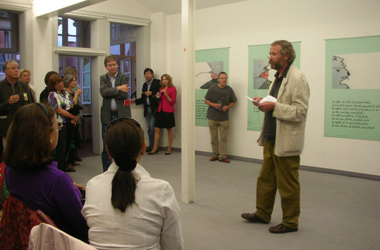 |
| © Yeon-Shin Kim-Hüppi |
The second day of the symposium was held in the Spiegelsaal of the Kurhaus, where 25 years ago the first Georg Groddeck Symposium took place (as documented in the “Groddeck Almanach” of 1986). This day was devoted mainly to Groddeck’s psychosomatic-medical impact.
First, Jürgen Schulz spoke about his application of Groddeck’s psychosomatics in his many years as an obstetrician, under the heading “Die Geburt der Mutter. Psychotherapie während der Geburt und die Folgen”.
The psycho-cardiologist Jochen Jordan provided us initially with some deep insight into his inner being, in good Groddeck manner, only to then introduce us to the fears of patients and doctors in cardiology and their defence mechanisms, under the heading “Das Unbewußte am Kathetertisch”.
Helmut Grosch took us one anatomical floor lower with his lecture “… damit da unten endlich Ruhe reinkommt”. He reported, sometimes very humorously, from his practice as a colon-proctologist on a theme which Groddeck frequently dealt with: digestion and patients’ intense preoccupation with it.
The morning programme closed with a historical-literary lecture by Helga Elisa Böhler on Karen Horney, one of the few disciples of Groddeck from the Berlin circle of psychoanalysts, and the culture of the 1920s.
The afternoon was in the capable hands of our three foreign guests. First Lazslo Avila from southern Brazil told us something about his treatment of Latin American agricultural workers. In his impressive lecture “Psychoanalytical Psychosomatics with and from Georg Groddeck” he illustrated how he uses Groddeck’s psychosomatics to great avail in Brazil.
This was followed by the lecture “Taktvolle Grenzüberschreitung. Echos und Konsonanzen von Groddeck in der heutigen Arzt-Patient-Beziehung” by Giancarlo Stoccoro from Italy, dealing mainly with Groddeck against the backdrop of the doctor-patient relationship and work in Balint groups.
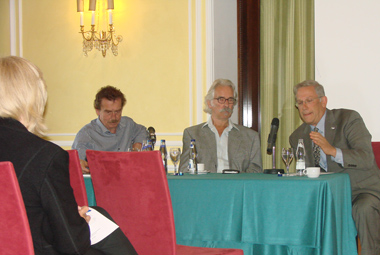 |
| © Anne Cost-Schneider |
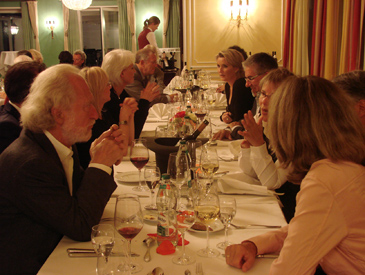 |
| © Anne Cost-Schneider |
Sunday morning began again in the Gartenhaus of the municipal library with a lecture by Helmut Siefert entitled “Groddeck und der Struwwelpeter”, a literary figure which Groddeck repeatedly dealt with.
Then, basing her contribution on Emmy Groddeck’s notes, Beate Schuh told us something about the last days of Georg Groddeck: “… morgens um fünf war es aus. Das Herz stand still”. We were all very moved.
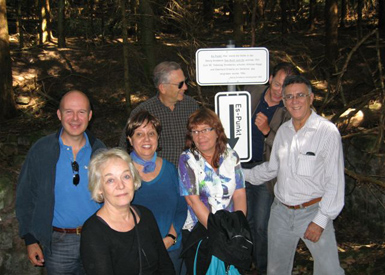 |
| © Sigrid Deussen |
Michael Giefer
